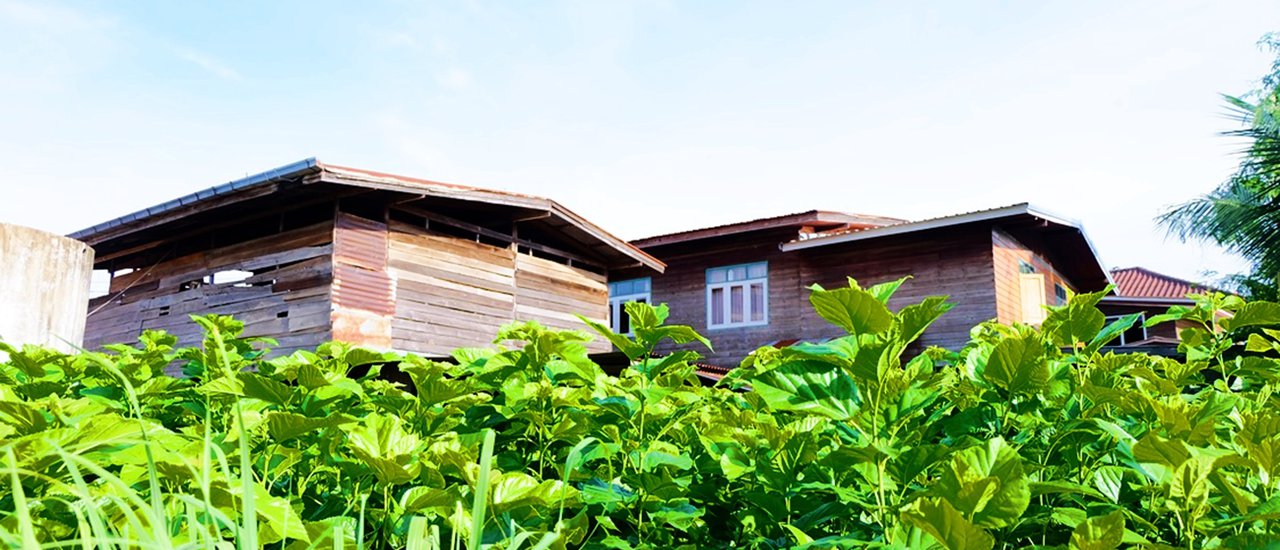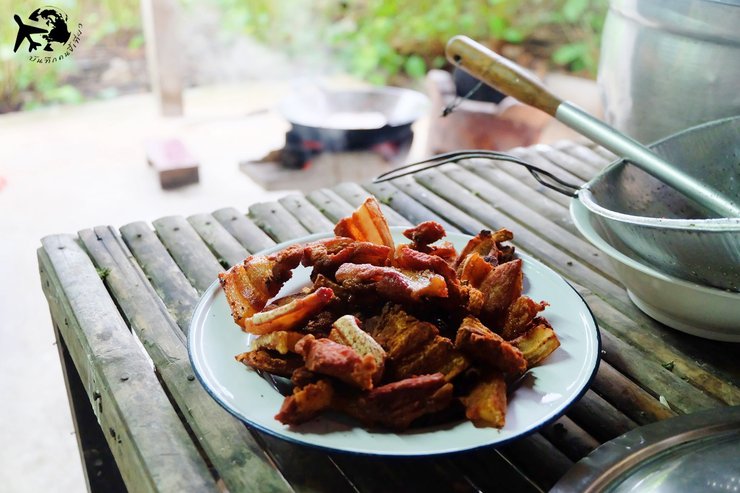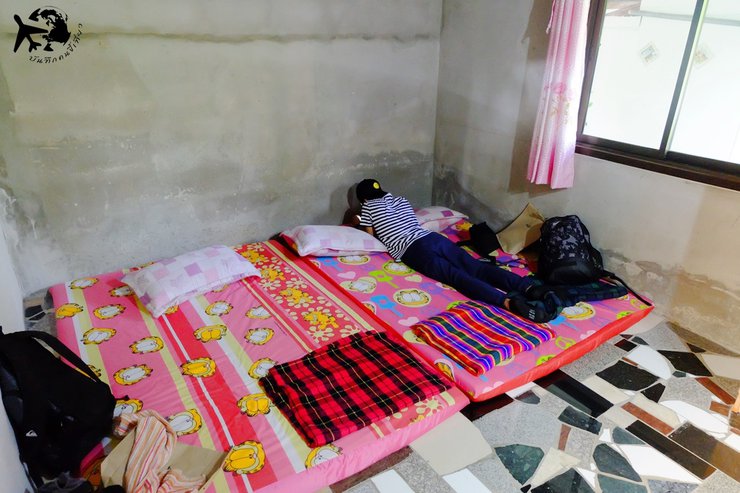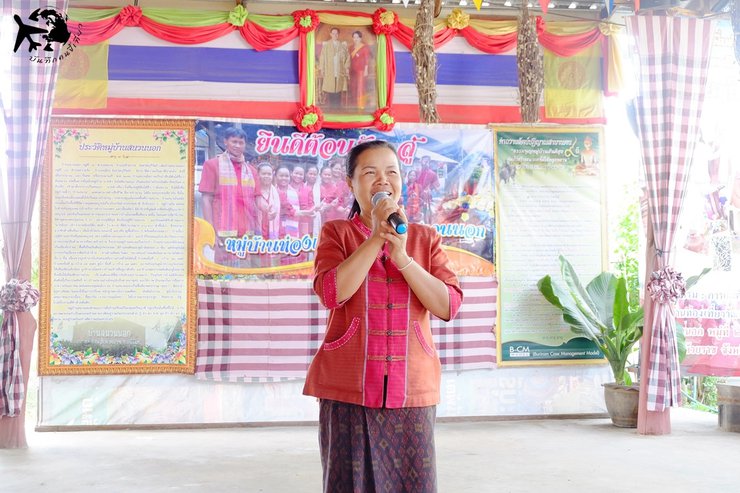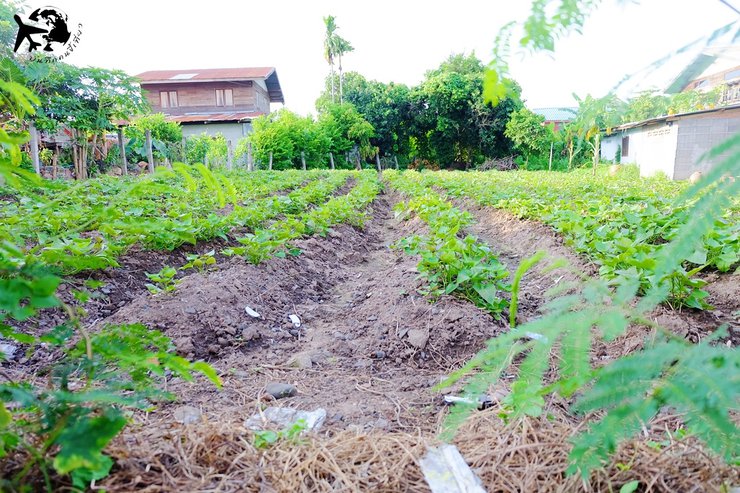
Traveler's Diary: https://www.facebook.com/khonkheetiew/
A Journey to Baan Sanuan Nok: Homestay, Silk Weaving, and the Essence of Isaan Culture
This article invites you on a captivating journey to Baan Sanuan Nok, a charming village nestled in the Huai Rat district of Buriram province, Thailand. The narrative unfolds with an enthusiastic greeting, highlighting the allure of this hidden gem and the promise of an unforgettable experience.
The author's invitation stems from a collaboration with the Buriram Provincial Tourism and Sports Office, who extended an invitation to explore the village and immerse in its unique cultural tapestry. Driven by a desire to delve deeper into the lesser-known Isaan region, the author readily accepted, embarking on a path to discover the essence of Baan Sanuan Nok.
The article's structure revolves around three key themes: homestay experience, silk weaving, and cultural immersion. These elements intertwine to paint a vivid picture of life in Baan Sanuan Nok, offering a glimpse into the community's traditions, artistry, and warm hospitality.
The author's enthusiasm is palpable, inviting readers to join them on this exploration of Isaan's rich cultural heritage. The use of vivid imagery and descriptive language promises to transport readers to the heart of Baan Sanuan Nok, allowing them to experience its charm firsthand.
This journey promises to be more than just a travelogue; it delves into the heart of a community, showcasing its unique way of life and the enduring spirit of Isaan culture. Through the author's lens, readers will gain a deeper understanding of the region's traditions, artistry, and the warmth of its people.
...We've gotten to know Baan Suan Nork fairly well, haven't we?...

A small village in Buriram province with an intriguing history. Approximately 150 years ago, it was a dense forest with a tree called "Son Wan." Mr. Dam, a native of Roi Et, established roots here. Currently, Ban Son Wan Nok, Village No. 2, is located in the Son Wan sub-district of Huai Rat district. The local language is Khmer, and the residents live simple, harmonious lives. They have a long tradition of mulberry cultivation, silk production, and silk weaving.
Travel route
- "Sanuan Nok" is located on the rural highway, Huai Rat - Krasang Road, 2 kilometers from Huai Rat district and 12 kilometers from Buriram city center.
- Conveniently accessible by public buses/trains from Buriram Province.
Silk-Weaving Lifestyle Tourism Destination
"Baan Sanuan Nok" offers village guides to facilitate tourists in observing the silk production process from the very beginning, as follows:
- Waking the silkworm - Harvesting mulberry leaves: Observe and learn about mulberry cultivation, mulberry tree propagation, and mulberry leaf harvesting for silkworm rearing.
- Silk farming: Learn about raising silkworms, feeding silkworms, and reeling silk from cocoons.

Home Stay
"Baan Sanuan Nok" offers at least 15 clean and comfortable homestays for accommodation, with breakfast included at affordable prices. Alternatively, modern resorts in the village and district can accommodate at least 100 people.
Community Products
- Traditional local silk patterns include squirrel-tail silk (Kraniw), sarong, loincloth, and smooth silk.
- Embroidered shawls with dok kaew and dok piku patterns are popular among foreign tourists.
- Processed silk products, such as shirts, multi-purpose bags, pencil cases, key chains, fabric dolls, etc.
- Local delicacies include bamboo sticky rice, stir-fried crickets with herbs, and "grayartsarot" (a sweet sticky rice wrapped in banana leaves).
- Must-try dishes include banana curry, taro stem salad, papaya salad with ant eggs, and rice noodles with fish curry.
Tourist season
- Every May (April), the "Songkran Festival" is held, which coincides with the annual festival of the Phanom Rung tradition in Buriram Province, which takes place during the same period and on the same Highway 24.
The Boun Doun Ta Festival: Honoring Ancestors and Family Unity
In the tenth month of the Thai lunar calendar (September), the Boun Doun Ta festival takes place. This ceremony serves two important purposes: honoring ancestors who have passed away and fostering unity among family members.
During this time, families gather to pay respects to their deceased loved ones. Offerings of food, flowers, and incense are made at altars or gravesites. These offerings are a way to show gratitude and respect for the ancestors, who are believed to watch over and protect their living descendants.
The Boun Doun Ta festival also provides an opportunity for family members to reconnect and strengthen their bonds. Shared meals, storytelling, and traditional games help to create a sense of community and belonging. This emphasis on family unity is a core value in Thai culture, and the Boun Doun Ta festival plays a significant role in upholding this tradition.

- Silk Degumming and Tie-Dyeing: Witness and learn the process of degumming silk fibers / Preparing silk threads for tie-dyeing / Natural dyeing / Learn the art of tie-dyeing and dyeing silk threads.
- Silk weaving: Observe and learn the art of silk weaving.
- Silk pattern processing and creation, observe and learn about silk processing, pattern drawing, and various printing patterns on silk fabrics.
Interesting information from http://buriram.bru.ac.th/index.php/en/burirumdata/otop/otopvillage/38-sanuannok
Let's get down to business, shall we? What we've covered so far was just the introduction. Haha!
Let's sleep at Baan Sanuan Nok Homestay.
Upon arriving at Baan Suan Nuan with the Tourism and Sports Office of Buriram Province team after a bus ride from Bangkok, we made several stops along the way to visit and eat at various locations, but we won't talk about those just yet. Instead, we'll take you straight into the village. As soon as we entered the village, we boarded a space shuttle, a warm welcome from the villagers. We then gathered together, as every place has its own rules and etiquette, and it's important to understand the history and background of "Baan Suan Nuan Nok" before exploring further.

After a warm welcome and a refreshing Welcome Drink (it looked good, right? 55), it was time to announce the lucky winners who would be sleeping in homestays. All the houses were real homes of local villagers, not resorts or hotels. We would be sleeping with the actual homeowners. Our group of four was assigned to the home of "Mae Nid," a kind and easygoing woman from Buriram who also makes delicious fried pork belly (off topic). However, the village headman informed us that some villagers here smile more than they speak because their primary language is Khmer. Yes, you read that correctly, "Khmer." Some of them may not be very comfortable speaking Central Thai, especially the older generation.
This is the house of Mae Nid in Ban Son Wuan Nok, where we will be spending the night. The atmosphere is warm and welcoming. Every house has silk weaving equipment. My friend asked if there were any silkworms to eat, and to his surprise, there were! I will tell you more about it later.



We have two bedrooms at Ma Nid's house, two people per room.

My mother, Nid, makes the most delicious deep-fried pork belly in fish sauce. The moment it touches your tongue, it melts all the way down to your large intestine. It's so good that I have to tell everyone who sleeps at my mother's house,
"So, we get to eat delicious things like this, while other families get to eat other things. Haha (why am I saying this?). Okay, that's it."

"Hey, hey, hey... what else does Ban Son Duan have to offer besides the homestay experience with the locals?"
Note: The original text is empty, so the translation is also empty.
On the day we went... and in the future, there will be a local market in the middle of the village of Ban Suan Nok. What will be there? Let's go see.
...The atmosphere inside the simulated market in the middle of the village

Local products are available for sale. There will be a demonstration of silk reeling (we'll talk about silk weaving later...).




In addition to selling various local products, a major highlight of visiting Ban Suan Nอก is the opportunity to see the houses of Buriram villagers who still preserve their traditional tools and utensils, just as their ancestors have passed down. This includes wood-fired stoves, rice scoops, and even the practice of drying chilies and onions using the heat from the rice cooker, which is a testament to their traditional knowledge and wisdom.



"Take me to weave silk...at Baan Sanwan Nok"
"Sericulture, in addition to being a supplementary income for farmers, is also an ancient and noble culture of Thailand that has been passed down for generations. No matter how the country's economy changes, the development of sericulture must continue." Royal Speech by Her Majesty Queen Sirikit on January 19, 1999.
As I mentioned earlier, "Baan Sanuan Nok" is famous for its mulberry cultivation, silk farming, and silk weaving. The local silk, known as "Hang Karok Kuen" silk, is a unique characteristic of the area. During our visit, the villagers demonstrated the silk reeling process and allowed us to try it ourselves. However, the highlight was the opportunity to taste "Dak Daet" or "silkworms," which were surprisingly delicious (although I'm not sure how relevant that is). This was an unexpected bonus to our trip to Buriram, where we learned about the silk-weaving traditions and lifestyle of Baan Sanuan Nok.


Silk reeling process
1. Heat water to approximately 70-80°C and add 40-50 cocoons to allow the heat from the water to dissolve the Sericin (protein) that binds the silk fibers.
3. Once the cocoons float, they are gently gathered and pulled apart to extract the silk fibers. These fibers are very small, so many of them are combined to create a single thread.
4. The silk is drawn out through the slits of the wooden frame, ensuring evenness and preventing the cocoon from following the silk thread. The drawn silk passes through the warping beam and is wound onto a suspended reel or a spinning wheel attached to the pot's mouth, before being collected in a basket.

5. Regularly add new silkworm cocoons to the boiling pot.
6. The silkworm cocoons will be completely unwound, leaving only the pupae, which will sink to the bottom of the pot. The pupae are then scooped out.

As previously mentioned, silkworm pupae from boiled cocoons are incredibly delicious. The silkworms continue to emerge until only the cocoon shell remains. This is the same material used for facial exfoliation. Inside the cocoon shell, you'll find the "silkworm," which is surprisingly delicious. Don't be grossed out! It's truly tasty.
Note: The original text is empty. There is nothing to translate.



After the silkworms have spun their cocoons, the villagers will then take the silk and process it through natural dyeing methods. Finally, they will hand-weave the silk, using tools and equipment to assist them. As I mentioned earlier, "this area is famous for its squirrel-tail patterned fabric."
"The squirrel-tailed cloth" is an ancient woven fabric with a simple pattern, but it is also intricate and beautiful. It uses the technique of weaving fabric.
The unique characteristic of the Tai ethnic group is the "line control" or what Thais call "squirrel tail cloth".
The squirrel-tail cloth is an ancient fabric commonly found in the southern Isan region, including Nakhon Ratchasima, Buriram, Surin, Sisaket, Ubon Ratchathani, and in the southern region of Nakhon Si Thammarat, Trang. "Hol perah" and women wear it as a sarong woven in stripes, called "hol sraey".
The Name "Squirrel-Tail Cloth": A Reflection of Its Unique Pattern and Weaving Technique
The name "squirrel-tail cloth" likely originates from the fabric's distinctive pattern, which resembles the shimmering, fine lines found in a squirrel's tail. This resemblance is particularly evident in the woven texture of the cloth. Interestingly, the name of this fabric varies across different regions, often reflecting specific characteristics. For example, in some areas, it is called "wa cloth" or "long cloth" due to its length, which is twice that of a typical sarong. In other regions, it is known as "quab cloth," referencing the "quab" weaving technique employed in its creation. However, the name "squirrel-tail cloth" remains the most widely used and recognized term for this unique fabric.





Indeed, as I mentioned, the silk here is truly "exquisite," living up to its renowned reputation.
"Immerse yourself in the culture of southern Isaan."
The Essence of Homestay: Cultural Immersion and Local Traditions
This final point brings us full circle to the initial promise of this homestay experience: the opportunity to learn about local customs, traditions, and cultural practices. This aspect of the visit truly impressed me. During our stay, we were treated to a traditional dinner in the style of the Sanwan Nok villagers. When guests arrive, they are welcomed with a "khantoke" (not exclusive to the north, as some might believe) and entertained by the enchanting sounds of Khmer-style music, often referred to as "kantreum." This was my first encounter with the original, authentic form of this music, and it was a truly remarkable experience.


I also got to see a blessing dance from young ladies.

Followed by a blessing ceremony in the style of... Baan Sanuan Nok.


The Thrill of the Chase: The "Reu Mod" Boat Race in Southern Isan
The "Reu Mod" boat race, a unique spectacle found only in southern Isan, is an experience that guarantees excitement and exhilaration.
The "Ruea Mon Tord" is a traditional Laotian New Year's game played in southern Isaan. It is believed to bring joy and prosperity during the New Year celebrations. Traditionally, the Lao New Year was celebrated in April.
The Ritual of the Matorad Boat: A Celebration of Renewal and Community
The Matorad boat ritual, observed exclusively in April each year, serves as a period of respite and rejuvenation for the community after a long season of arduous labor. The ritual involves a procession of elaborately decorated boats, accompanied by music and dance, visiting every household in the village. Upon their arrival, the residents, following tradition, warmly welcome the performers and offer them various necessities, including food, clothing, and money. These offerings are subsequently collected and donated to the local temple.
This ritual embodies a profound cultural significance, reflecting the community's deep-rooted values of communal support, generosity, and spiritual devotion. The act of offering to the performers symbolizes the community's gratitude for their dedication to preserving this cherished tradition. Moreover, the donations made to the temple underscore the community's commitment to upholding their religious beliefs and supporting their place of worship.
The Matorad boat ritual stands as a testament to the enduring power of tradition in fostering social cohesion and spiritual well-being within the community. It provides an opportunity for collective celebration, reaffirming shared values and strengthening bonds among community members. The ritual's unique blend of entertainment, generosity, and religious devotion makes it an integral part of the community's cultural identity.
The performance of the "Kantruem" involves singers and dancers, led by a lead singer known as "Phor Pleng" or "Mae Pleng". Other singers join in as "Luk Khu". Musical instruments include two or more "Kantruem" drums, cymbals, gongs, "Saw", and "Chok Krong". Notably, the "Kantruem" drum is always present in every performance.
The lyrics of the "Reu Mon Trad" performance begin with a request for permission from the homeowner, followed by other appropriate sections, including a request for donations, a flirtatious dialogue between young men and women, and finally, a blessing for the homeowner and a farewell song before the "Reu Mon Trad" group moves on to another house.



…The villagers' various activities brought us joy and laughter. As night fell, it was time to rest, for the next morning we would walk to the temple to make merit. During our visit, we also had the opportunity to participate in the morning alms offering and walk to the temple with the villagers, carrying our food containers. It felt like a long time since we had done anything like this.



This trip was absolutely worth it! Not only did I get to experience community-based tourism and learn how to weave silk, but I also gained insights into the diverse cultures of the region.
I have not had much experience with this myself...
If you are a tourist and want to visit Ban San Nuan Nok or Buriram, I recommend that you contact the Buriram Provincial Tourism and Sports Office. http://www.mots.go.th/province_new/ewt/buriram/ewt_news.php?nid=162
Tel. 0-446-66528 Fax. 0-4466-6527
E-mail: [email protected]
https://www.facebook.com/buriram.mots
Kor-eea
Friday, September 27, 2024 10:25 AM

